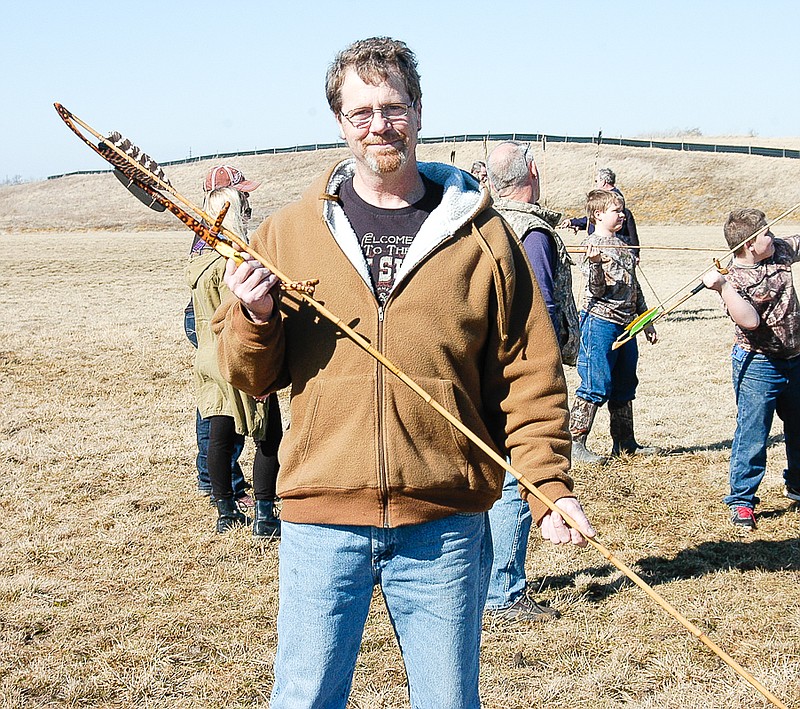The Missouri Department of Conservation sponsored a primitive weapon introduction session Saturday, March 7. The all-day session was held at Central Regional Office in Columbia, beginning with classroom sessions about the history, making and use of the bow, the longbow and a really primitive weapon, the atlatl.
About 75 people took part, with most eventually trying both the longbow and the atlatl.
In a time of compound and recurve bows, the idea of using a more primitive longbow seems easy. It is not.
First, most of those who use longbows and atlatls have at least some input into the actual weapon used. The purists will make their own bow and arrows for the longbow, and thrower and dart for the atlatl.
According to the instructors, the term "longbow" has nothing to do with size. One simple dictionary definition is "a wooden bow drawn by hand." Quickly learned was that the bow is used held slightly at an angle, while standing at a slight crouch. This stance helps with aim, as well as helping keep the arrow nocked while preparing to cast it. It takes only a few arrows to gain a little skill, but hunting, or even accurate target shooting, is going to take a lot of practice.
The atlatl is a very primitive weapon, likely the next step from spear throwing. It consists of a thrower about the length of the users arm, and a light spear called a dart. They were used to bring down mammoths and other smaller game possibly as long as 20,000 years ago. The atlatl dart is fletched with feathers, so it looks like a long arrow. Some of the darts have a detachable point, which sticks in the hunted animal, so the dart remains unbroken and can be reused. The thrower has a hook which fits in a small depression in the feathered end of the dart. The atlatl dart is slower than an arrow, but since it is about three times the weight, it can be a more effective weapons for big game, in the right hands.
An atlatl is a little tricky at first, but once the person gets the hang of keeping the dart on the thrower, it can be used. However, a lot of practice would be required to consistently hit a target or hunt with one.
Fortunately, Dawn and Brian Wagner were among those at the demonstration and practice. Dawn currently holds the number one position in the world atlatl competition. Brian is the only person in Missouri to have taken two deer with an atlatl. Dawn said she once took a rabbit with an atlatl dart, proving not only that it can be used for small game, but that she is very good with it.
Missouri made deer hunting with an atlatl legal in 2010, one of only two states to do so. There were several members of the Missouri Atlatl Association on hand to introduce others to their sport.
Both atlatls and longbows can be made by the user or purchased with in kit form or complete and ready to use. The best wood for a longbow, according to Tab Leach who was one of the presenters and demo leaders, is Osage Orange. That isn't as easy to find as a Missourian might think, since it needs to be a straight piece about six feet long and as big around as a coffee can. Making it is something that is going to take awhile, since the wood has to be aged at least nine months.
The atlatl dart can be made from river cane and the thrower from a piece of wood. There are many thrower designs, so each of the users should be able to find one to suit themselves.
Several present said the primitive weaponry allows them to connect with history and ancestors. One man said he likes the idea that he can always make his own weapon and ammunition.
The day included a tour of the Grayson Archery Collection owned by the University of Missouri Museum of Anthropology housed at the Museum Support Center on Rock Quarry Road. The collection contains more than 5,000 pieces from all over the world related to archery. Included are many items of Chinese archery, Korean Archery, Islamic Crescent Archery, American Archery and modern archery. Some items are included because they feature painting or drawings of archers and archery. Others are points, arrows, spears, bows, bowstring boxes quivers, thumb rings and more.

